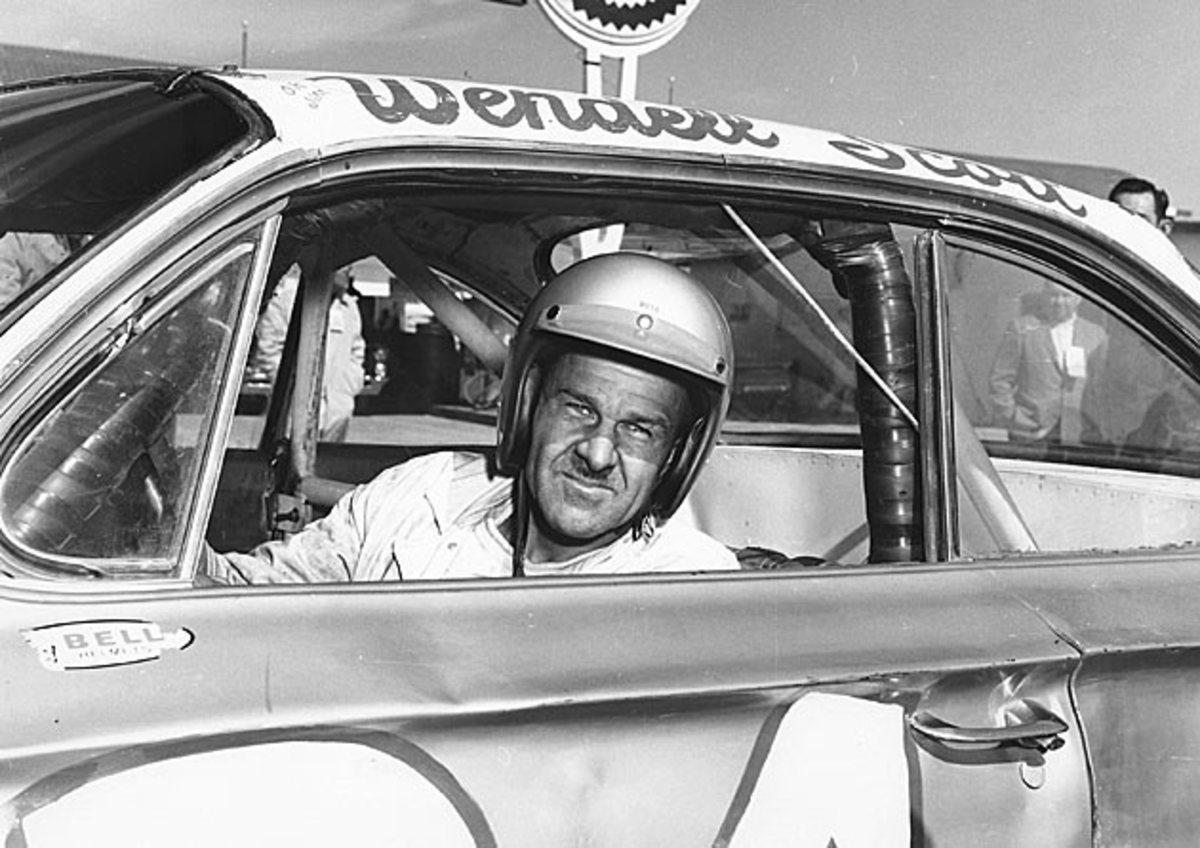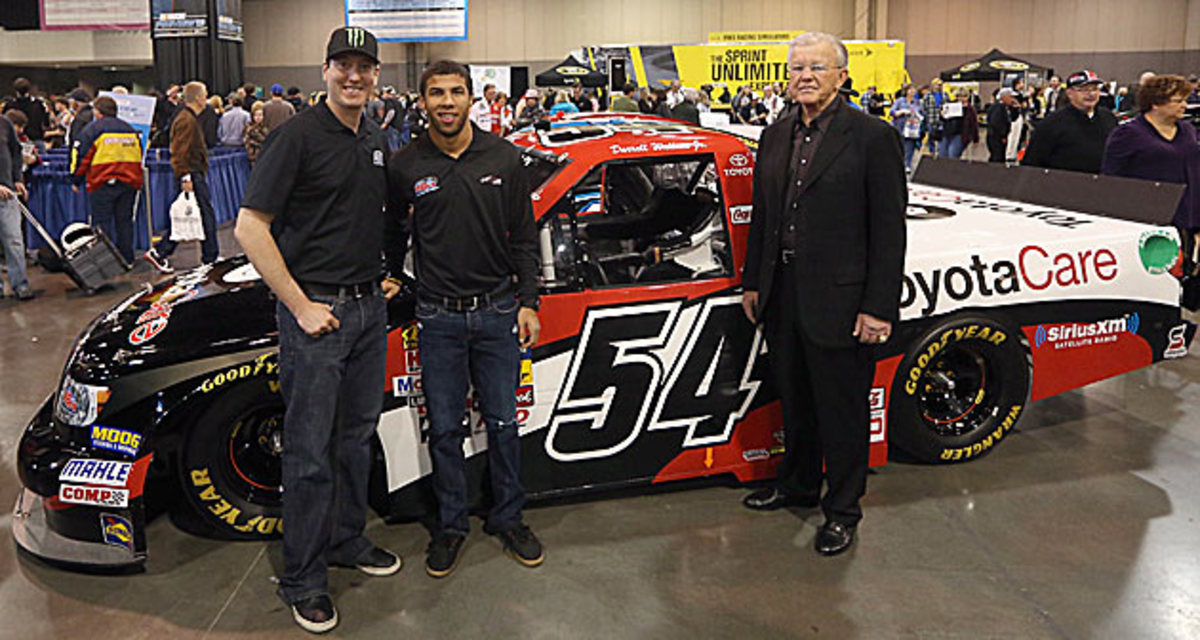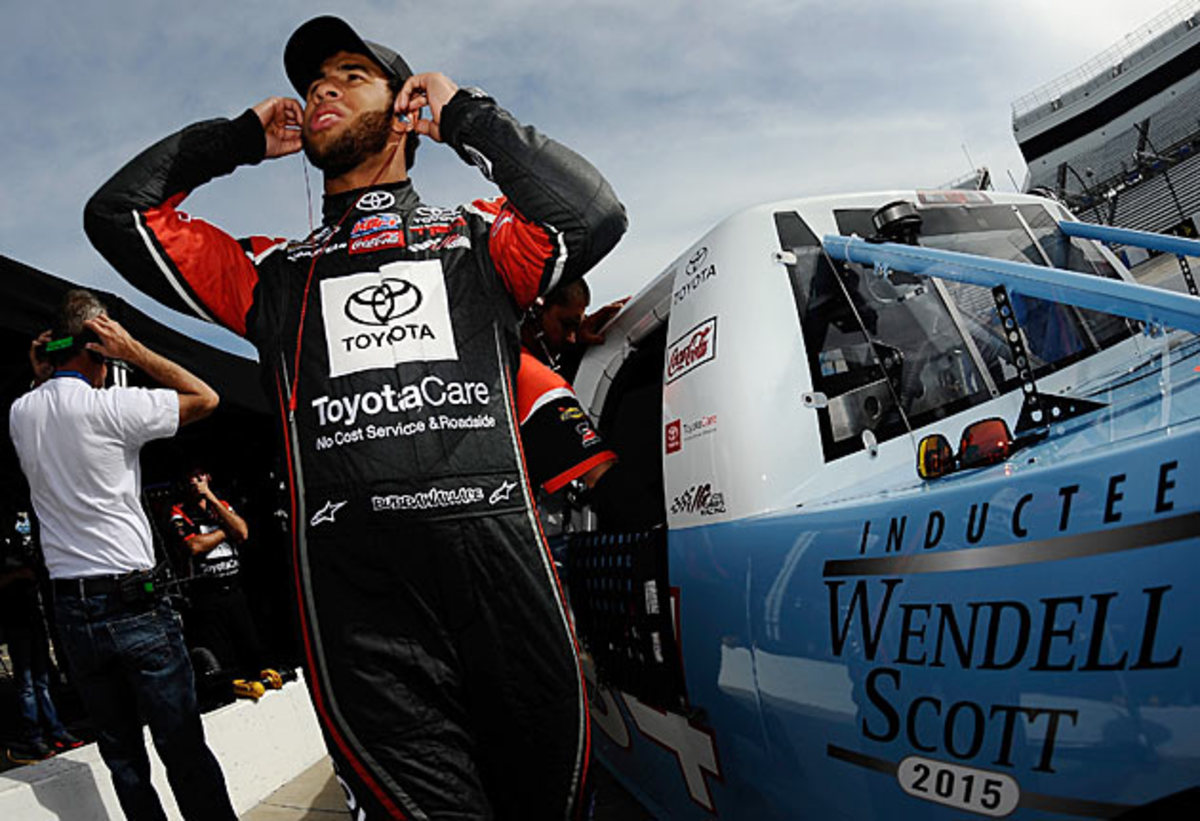NASCAR's Darrell Wallace Jr. blazing the way for minority drivers

He has the best equipment, teammates who are completely committed to his cause, and the firm backing of one of the best owners in the business. They are luxuries that Darrell Wallace Jr. can’t take for granted. Not in his sport, not even now.
Motor sports are hard enough to excel in as it is—what with all the support, money and luck a racer needs just to be moderately successful. But no one has it harder than those who drive while black. Wallace can’t escape this reality, even as he heralds the coming of a new day in NASCAR. No matter what he accomplishes on the track—and the fact that Wallace is on the cusp of completing his second full year racing in the Camping World Truck series should provide some hint of what kind of achiever he can be—its racial significance always takes precedence.
Four years ago Wallace hit a double off the wall, so to speak, as a rookie in the K&N series, NASCAR’s triple-A division, when he became the first African-American to win a race and take home rookie of the year honors. Last year he blasted one out of the park in Martinsville, Va., grabbing the first checkered flag by an African-American in a national touring NASCAR race in 50 years. That the 21-year-old Concord, N.C. product was also among the youngest racers to accomplish any of those things, or drive for Kyle Busch Motorsports—a team fronted by one of the Sprint Cup series’ hottest stars and owned by former NFL head coach Joe Gibbs, a man who has been to his share of mountaintops—barely even came up.
Not that Wallace minds being touted as NASCAR’s Jackie Robinson. The visibility that comes with all that hype just gives him a chance to acknowledge the path blazed for him by racing’s true Robinson: Wendell Scott, a 13-year racing veteran who in 1963 preceded Wallace in NASCAR’s win column with a triumph on a half-mile dirt track in Jacksonville, Fla. “It’s been very cool to carry his torch,” Wallace says.
NASCAR Chase Week 7: Martinsville Racing Power Rankings
For his title defense at Martinsville this Saturday (1:30 p.m. EDT, Fox Sports 1), Wallace is raising his Scott awareness campaign another notch. He’s turning his Toyota Tundra into a rolling replica of Scott’s old car, switching his paint scheme (from red and black to blue and white) and his number from 54 to Scott’s 34.
The tribute acknowledges Scott’s posthumous selection to the 2015 NASCAR Hall of Fame class, which will be honored by a series of ceremonies at Martinsville this weekend. It’s also a welcome excuse for Wallace to gather with his mutual admirers in Scott’s family, who are expected to be at the .5-mile track to cheer him on. “Having a connection to the family is awesome,” says Wallace, who first linked up with them back in 2010. “They’ve been very supportive. Wendell Jr. texts me nonstop.”
Another win at Martinsville will improve Wallace’s chances of finishing the year ranked in the top three in the point standings—a feat that no black driver has come within miles of achieving. Crew chief Jerry Baxter has been preparing Wallace for the prospect of another historic moment since Wednesday. “Race win right here” was all he said as Wallace was leaving the KBM shop for the day, and that bold statement had his crew bouncing echoes of “Yup, that’s right!” across the room like super balls.
“It’s going to be a special weekend for us,” Wallace said.
Game changer

The echoes in Wallace’s wake weren’t always so comforting. When he ditched AAU basketball as a nine-year-old to break into the ultra-competitive racing scene in the southeast, his new rivals on the track were less than welcoming. They didn’t know what to make of this new jack with the black mother and white father. “It was confusing for outsiders looking in,” Wallace says. So they made him an object of scorn. Fans, promoters and even an official called him hurtful names and conspired to invalidate his results.
The struggle is not unlike the one that Scott faced decades earlier; the key differences, of course, are that Scott faced his trials as a grown man during the thick of the Civil Rights movement while Wallace was just a boy growing up in a country run by a president who mirrored his own biracial image. Wallace’s parents would do their best to cocoon him from the many slights against him that were born of fear and ignorance, but there was no patching their shield after their son came home from middle school asking what the N-word meant.
“My parents definitely kept a cool head about all the negative thrown our way and told me how to handle it,” he says. “I just had to be the better man in the situation and go out there the next weekend and continue to dominate.”
The more Wallace produced behind the wheel, the more difficult it became for detractors to sustain their hate-tinged chorus. A string of 46 victories between 2005 and ’06 while racing bandoleros (like a Cup car, but half the size) and legend cars (think of a 1930s car at 5/8ths scale) changed the tone of the conversation about him. He went from being a freak show to a freak talent.
In 2009 Wallace signed a development deal to race for Joe Gibbs, a three-time Super Bowl-winning coach who turned colorblind well before leaving the NFL for NASCAR in the early-90s. While the offensive coordinator of the Tampa Bay Buccaneers in 1978 he compelled the organization to select Grambling quarterback Doug Williams in the first round of the NFL draft—a bold move during a time when black quarterbacks didn’t play much at that position in the pros, let alone get drafted that high. Eight years later, when Gibbs became head coach in Washington, he signed Williams as an insurance policy behind starter Jay Schroeder and turned the team over to him late in the season after Schroeder went down with an injury.
It took Williams leading Washington to Super Bowl XXII for Gibbs to notice his skin color. “All the guys on our team I think felt the same way,” Gibbs says. “Doug was our quarterback. But then we get to those two weeks out in San Diego, and [race] was a huge part of the lead up. That’s when I grasped it. Like, Ohmigosh, Doug’s actually going to be the first black quarterback to start in a Super Bowl.
“And then of course to see the way it played out [with Washington riding an MVP performance from Williams to a 42-10 romp over the John Elway-led Broncos], that was such a thrill. I’d love to do the same thing in racing.”
[pagebreak]

Top down
Gibbs has been trying since 2003, when he started a team expressly to help minorities and women break into racing. A year later, NASCAR backstopped that effort with its own program, called Drive for Diversity—which, among other things, holds a combine to identify talented drivers and crewmembers, and cobbles together enough sponsorship support around them to make it feasible for teams on its three national levels to take on all this talent.
Before that, there had been plenty of pioneers but no real pipeline. Scott, an Army veteran of World War II, raced on handed down equipment and served as his own pit crew. He died in 1990 at age 69, a bitter and broken man. Willy T. Ribbs, a multi-discipline racer from San Jose with open-wheel credits in CART and Formula 1, failed to stick after three races in the 1986 Cup schedule and 23 more in the truck series in 2001. Bill Lester, a Washington, D.C. native with a science degree from Cal and work experience at Hewlett Packard, lasted eight years in the truck series but never won or got much of a shot to race Cup cars.
That lack of progress wouldn’t look so bad if Scott hadn’t broken into NASCAR in 1952—two years after the NBA had become integrated. While no one expected that the two sports would mirror each other in terms of racial makeup, the fact that the garage population looked more or less the same as it did when NASCAR raced on dirt tracks was impetus enough to take action. But whereas NASCAR's effort takes a bottom-up approach to integration, Gibbs had initially hoped to tackle the issue from the top. His diversity program was conceived to run through a JGR subsidiary owned by Hall of Fame pass rusher Reggie White. “He moved into the community here [in the Charlotte-area],” Gibbs says. “We were gonna pick the drivers.”
Months before their work was to begin in earnest, however, White died of cardiac arrhythmia at age 43. The most he was able to complete was a few picks for his team. One of them, Aric Almirola, a Cuban-American from the Daytona Beach area, is currently racing in the Cup series for Richard Petty Motorsports and made the Chase playoffs this year after hanging on for a victory in the summer race at Daytona. “I’m really proud of the fact that I got an opportunity to drive for Joe Gibbs Racing and their diversity program,” Almirola said after his Daytona triumph in July. “It’s really cool to think that 50 years ago, my grandparents just decided, ‘Hey, we don’t like the direction our country is going. We’re going to give everything back to the Cuban government and move to America.’ It’s really amazing to think that out of all the people in my family, I’m benefiting the most from that decision.”
In the decade that Almirola has been a part of NASCAR, the sport has seen more change than it did during the four decades after Scott’s landmark win, which he wasn’t even allowed to celebrate in Victory Lane. So charged were the times that first place was awarded to white driver Buck Baker, and the result was not officially corrected until hours later. Two more Hispanic drivers, Juan Pablo Montoya (of Colombia) and Milka Duno (Venezuela), would cross over into stock car racing from F1 and sports cars, respectively. Another open-wheel vet, Danica Patrick, emigrated from IndyCar and gets closer to becoming NASCAR’s first female winner with each Cup start. Kyle Larson, a Japanese-American, is a dazzling rookie of the year favorite in the Cup series.
Even the 7-foot former NBA All-Star center Brad Daugherty found room for himself in the sport as a studio analyst for ESPN and a part owner of one of its pluckiest Cup teams—JTG Daugherty Racing. And then there are all those multihued faces working behind the wall, on the race shop floor and in front offices across the league. While this revolution has been televised, it has gone largely unremarked upon—especially in comparison to other motor sports. Certainly NASCAR’s disappointing television ratings have played a role, but that downward trend in viewership is nothing that a bit more diversity can’t slam into reverse. All NASCAR has to do is the one thing it does better than any other major sport: embrace change. “NASCAR should be for everyone,” Gibbs says.
Sign of the times

Wallace, a truck driver, is ideally suited to lead this new bandwagon. He threatens to do to stock car racing what Tiger Woods did to golf. “It’s going to be a huge story,” Gibbs says, “and I think it’s gonna open a way for a lot of other kids.” Like Woods, Wallace has shown that the big leagues aren’t too big for him, that he’s a racer to be respected no matter the track. His landmark triumph at Martinsville capped a 2013 campaign that saw him seize a pole position at Dover, score five finishes in the top five and 12 in the top 10, and place eighth in the year-end standings. This season he added two more wins and two more poles. One of those poles was six months ago at Martinsville and it resulted in a second-place finish—which explains his crew’s confidence going into the weekend.
Gibbs sees even greater things in Wallace’s path. His plan is to add a fulltime Nationwide schedule to Wallace’s race load, and there’s little question he can handle the task. In six previous Nationwide starts he finished in the top 10 four times and grabbed a pole at Dover in 2012. “And then the step after that is the Cup,” Gibbs says. It’s a sizable jump, but Wallace has the right stuff to get there in a year or two. Along with his upward trending results, he has proved to be a hard worker—especially when it has come to relating his truck’s every nuance to the people in the pit box. “Whereas before Jerry was kinda guessing at what I needed,” Wallace says, “now I can sit down with him and my engineer Eddie [Troconis] and go over certain adjustments and come up with a game plan that we need for our Toyota Tundra to be a dominant truck.”
Wallace has also shown that he can turn back stiff competitors like Matt Crafton, the 15-year truck veteran who is currently topping the standings, and Busch, who isn’t above the odd minor-league tangle. If there’s an obstacle remaining in Wallace’s path, it’s not acceptance in the garage or even in the grandstands. “The flack I used to get has definitely decreased over the years,” he says. “I’m well accepted in the sport. The fans are actually what drive me to get out there and keep going.”
No, his biggest obstacle is sponsorship. Too many ad buyers in the racing community still remain skeptical of whether a young, telegenic black man can be an engine for hundreds of millions of dollars in business. Evidently, these people must not have watched a commercial during a sporting event or updated their business plans in half a century. “On the one side you’ve still got to fight through things,” Gibbs says. “But on the other side of it, there are a lot of people in our sport and a lot of corporations that are excited about [Wallace] and want to be a part of it.”
Last year’s victory at Martinsville, really, was just the beginning. Wallace, unlike Scott, was not only allowed to toast his historic triumph in Victory Lane but also gifted an awesome souvenir—a 7-foot, 130-pound grandfather clock that is now posting up a wall in his living room. If he wins another timely trophy this weekend, that antique won’t be keeping up with the current time as much as heralding a totally new one in NASCAR. And the ticking will resound in motor sports and beyond.
